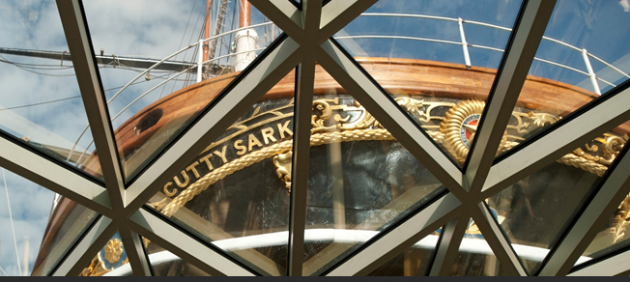The simple idea of suspending the famous tea clipper above her dry berth is sensational
She was one of the fastest commercial sailing ships ever built, capable of making 17 knots under a towering press of canvas.
The Cutty Sark, the last surviving tea clipper and the quickest, trading from Britain to China and Australia and returning with cargos mainly of wool and tea, is also one of the nation’s best loved maritime artefacts. She was one of the biggest attractions at the National Maritime Museum in Greenwich until the ship caught fire in 2007 and was almost totally destroyed.
Today the Queen celebrated the end of a five-year restoration programme and an ambitious scheme that has seen the ship raised 3m above her dry berth in Greenwich. For the first time, visitors can properly see the lines and underwater shape that were her elixir of speed.
Yesterday I went to the media preview day and talked to the chief architect and principal civil engineer – note, not the naval architect or marine structural engineer as would be the usual case with a ship. This a rare marriage of civil building project and marine restoration.
The results are stunning. From the waterline down, Cutty Sark is housed beneath a glass pavilion that protects her from the worst of the elements and allows visitors to see the ship from a very different perspective.
Outside, the glass roof fittingly makes it look as if the ship is sailing on a silvered sea as it reflects the sky. Even though the dry berth is the same one she sat in before, it now seems alive, whereas before poor old Cutty Sark appeared forlornly marooned in a concrete grave.
The work has cost £50 million – a distant cry from the original build price of £16,150 when she was built in Scotland in 1869. But there is a sound commercial argument for such a major revamp, as architect Chris Nash (himself a yachtsman) explained to me.
“It’s never been done before, as far as I know, to lift the whole intact structure of a ship and suspend it,” he says. “The great thing about that is, in this case [Cutty Sark] was actually crumbling on her decaying wrought iron frames as she was resting on her keel.
“The choice was either the ship was going to be scrapped and thrown way or we came up at a scheme which would provide a sustainable income. The Cutty Sark Trust had no land, so lifting the ship did two things: it relieved the stress on the existing historic structure; and, secondly, provided all this space [underneath] from which they can earn an income.”
“And,” he adds, “we hope the idea of lifting the ship and being underneath the hull will show people what is [the ship’s], the most important historic artefact. The construction of the hull was the most advanced technology of the time and the shape was what made her so fast.”

That profile is a thing of beauty. The shot above shows the bow sections of the ship. Walking underneath her keel and beneath the glass roof is a very strange sensation redolent of being underwater. The hull is resplendent in gold-coloured Muntz metal, cladding made from brass, copper and zinc that was an original and very innovative feature of the ship when she was built.
From below, you can also appreciate the immense scale of the ship: Cutty Sark is 280ft overall and must have been a mightily impressive sight when she set all of her 32 sails.

Even today modern container ships don’t exceed the passage times Cutty Sark set between Australia and Europe because most throttle back to ‘super slow steaming’ of about 12 knots to conserve fuel.
She could hit speeds of 17 knots, and in one occasion in 1889 she overtook the P&O Steamer Britannia, making 16 knots. The steamer’s watch officers were amazed and noted in the log: ‘Sailing ship overhauled and passed us.’
The restoration has restored or replaced many details of the boat, from parts of her framing to planking, tween decks, the 152ft main mast, 11 miles of rigging, right to the gilded scrollwork on her bow and the famous figurehead, Nannie, freshly revamped.
But, where possible, original planking, cast iron deck beams and salvageable wrought iron frames have been kept.

Suspending the 900 tonne ship was quite an engineering feat. Steve Brown, project principal from engineering firm Buro Happold, explains that it is as if she is held in a series of coathangers.
“There are ties going down to the keel that connect with a pin to struts that go down to the sides of the dry berth on both sides,” he says.
“These are all at slightly different angles, so that when you look along [the hull] they look like a fan. These take the 900 tonne weight and allow us to distribute the weight between the high levels of the mast and the lighter weight of the bow and the stern.”
The ship and exhibition opens to the public tomorrow. See www.cuttysark.org.uk
Follow more sailing news and views from me on Twitter: @elainebunting




